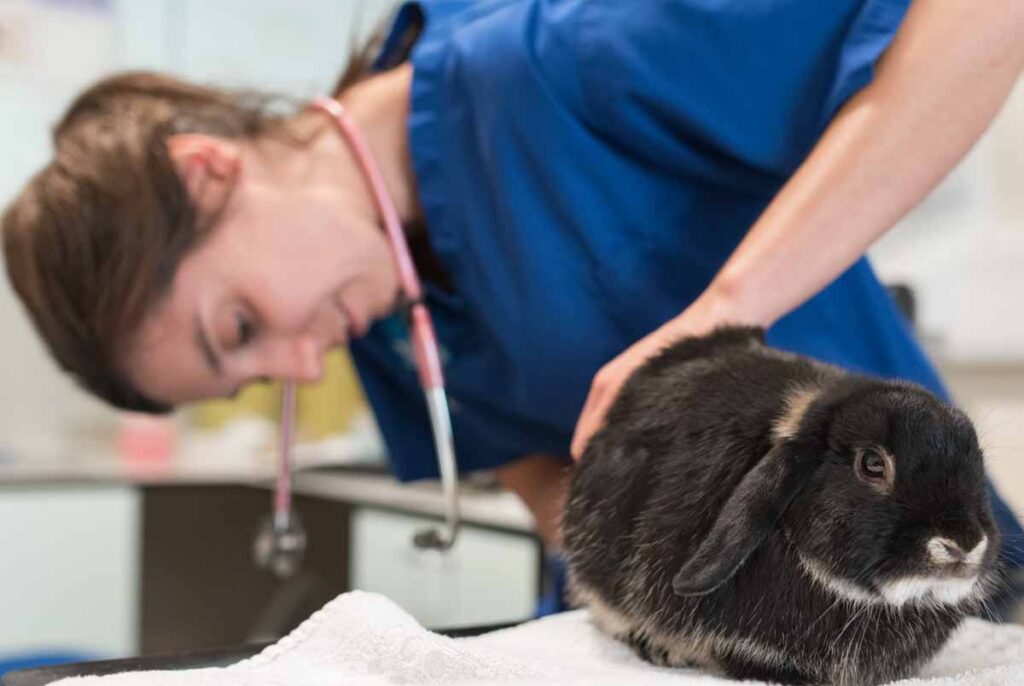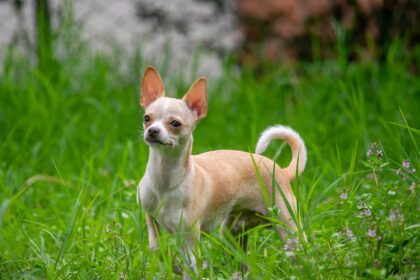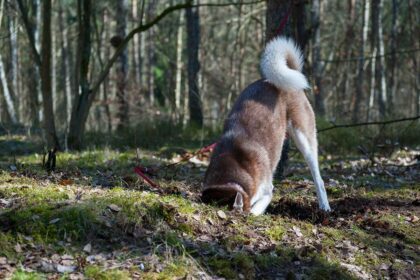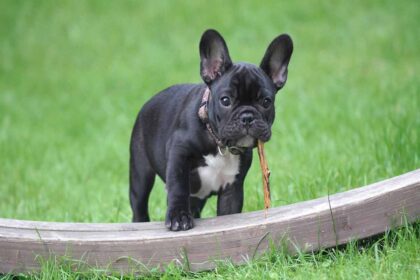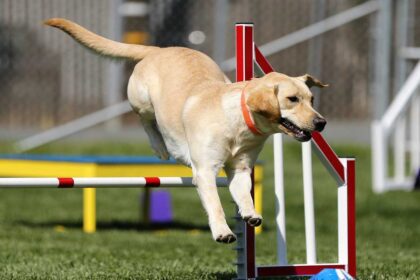Gastrointestinal (GI) stasis, a condition where a rabbit’s digestive system slows down or grinds to a halt, is a leading cause of concern for rabbit owners. While many resources discuss the common signs and treatments, GI stasis is a complex issue with far-reaching consequences for your bunny’s health. This blog post dives deeper, exploring the lesser-discussed aspects of GI stasis and empowering you to become an advocate for your rabbit’s well-being.
The Rabbit Digestive System: A Microbial Masterpiece
Unlike us omnivores, rabbits are hindgut fermenters. Their cecum, a pouch in the large intestine, acts as a fermentation vat. Here, a specific community of microbes, with a staggering 70-80% unique to rabbits, breaks down tough plant fibers into digestible nutrients. This delicate microbial balance is essential for extracting energy from their food and maintaining overall health. Disruption of this microbiome through diet, stress, or illness can lead to a cascade of problems, culminating in GI stasis.
Beyond the Usual Suspects: Unveiling Hidden Culprits
While dietary indiscretion and hairballs are well-known triggers for GI stasis, other, less-often-discussed factors can also play a role:
Dental Deceit: Overgrown teeth can cause discomfort, making chewing difficult. This can lead to a decrease in fiber intake, a cornerstone of healthy gut function, and ultimately contribute to GI stasis. Regular dental checkups are vital for preventing this silent threat.
Parasitic Plotters: Internal parasites can disrupt the delicate balance of gut flora and hinder gut motility, creating a breeding ground for GI stasis. Regular deworming is an essential part of preventive care.
Medication Mischief: Certain antibiotics, while crucial in fighting bacterial infections, can also disrupt the gut microbiome, increasing the risk of GI stasis [4]. Discuss any potential side effects with your veterinarian before administering medication to your rabbit.
The Silent Signs: Early Detection Saves the Day
Rabbits are masters of masking discomfort. However, by being observant, you can pick up on subtle changes that might indicate early GI stasis:
Cecotroph Conundrum: These raisin-like droppings are a sign of healthy gut function, as they are produced after the initial round of digestion and packed with essential nutrients for your rabbit to reingest. A decrease or absence of cecotropes can be a red flag for GI stasis.
Appetite Alarms: While rabbits naturally have fluctuations in appetite, pickiness or a sudden drop in hay consumption, their dietary staple, can be early signs of trouble brewing in their gut.
Lethargy Lag: A normally active rabbit becoming withdrawn or spending more time hunched over can be a sign of pain or discomfort associated with GI stasis. Early intervention is key to preventing complications.
Treatment and Prevention: A Multi-Faceted Approach
If you suspect GI stasis, seek immediate veterinary care. Treatment often involves a multi-pronged approach:
Rehydration Renaissance: Dehydration is a frequent consequence of GI stasis, as rabbits are often reluctant to drink when they’re not feeling well. Subcutaneous fluids or oral administration of electrolytes may be necessary to combat dehydration and restore gut function.
Medication Marvels: Gut motility stimulants can help get things moving again, while pain medication can provide much-needed relief. However, medication is just one piece of the puzzle.
Dietary Do-Over: A focus on high-fiber Timothy hay, the roughage that keeps their digestive system functioning smoothly, is essential for long-term gut health. Fresh vegetables and a small amount of high-quality pellets should complement, not replace hay.
Building a Gut-Happy Bunny: Proactive Strategies
By understanding the complexities of GI stasis and taking preventive measures, you can create a happy and healthy environment for your rabbit’s gut flora to flourish:
Dietary Dynasty: Unlimited access to high-fiber Timothy hay is the cornerstone of a rabbit’s diet. Fresh vegetables and a small amount of pellets should complement, not replace hay. Remember, a balanced diet is the foundation of a healthy gut.
Dental Defense: Regular vet checkups and providing chew toys that help wear down teeth are crucial for preventing dental problems that can contribute to GI stasis. A healthy mouth is a happy tummy!
Stress Management Sanctuary: Minimize loud noises, sudden changes, and provide ample hiding spots to keep your bunny relaxed. A stress-free environment promotes a healthy gut microbiome.
The Final Word: A Rabbit’s Gut – A Microscopic Marvel
The rabbit’s digestive system is a fascinating and complex ecosystem. By understanding the delicate balance of this microbial world and the factors that can disrupt it, we can become better guardians of our rabbit companions’ health. Early detection, prompt veterinary intervention, and a commitment to preventive measures are the keys to keeping your rabbit’s gut happy and their binky breaks plentiful.
Remember: GI stasis is a serious condition, but with knowledge and proactive care, you can empower yourself to advocate for your rabbit’s well-being and ensure a long and healthy life for your furry friend.
Further Exploration
Consult your veterinarian for personalized advice on your rabbit’s specific needs.
The House Rabbit Society offers a wealth of information on rabbit care, including GI stasis.
The National Geographic article “Gut Bacteria: The Microscopic Guardians of Our Health” provides a fascinating look at the role of gut microbes in overall health, applicable to rabbits as well.
Bonus Tip
Exercise and Enrichment are crucial for your rabbit’s physical and mental well-being. Playtime not only encourages movement, which aids digestion, but also helps reduce stress, another potential trigger for GI stasis.
Engage your rabbit with interactive toys that encourage digging, foraging, and hopping. Rotate toys regularly to keep things interesting, and consider supervised exploration time in a bunny-proofed area. A happy and stimulated bunny is a bunny with a healthier gut!
FAQs
Q. What is Gastrointestinal (GI) Stasis in Rabbits?
A. Gastrointestinal (GI) Stasis in Rabbits refers to a serious condition where the normal movements of the digestive system slow down or stop altogether. It often occurs due to a variety of factors including diet, lack of exercise, and stress.
Q. How can I prevent GI stasis in my rabbit?
A. To prevent GI stasis in your rabbit, ensure they have a proper diet rich in fiber, provide plenty of opportunities for exercise, and minimize stressors in their environment. Regular check-ups with a veterinarian can also help detect any early signs of GI stasis.
Q. What should I feed my rabbit to prevent GI stasis?
A. A diet high in hay and fresh vegetables is essential for preventing GI stasis in rabbits. Hay provides essential fiber that helps keep the digestive system moving smoothly. Additionally, limit sugary treats and pellets, as they can disrupt the delicate balance of the rabbit’s digestive system.
Q. Can GI stasis in rabbits be fatal?
A. Yes, GI stasis in rabbits can be fatal if not promptly addressed. Without proper treatment, the condition can lead to severe dehydration, organ damage, and even death. It’s essential to recognize the signs early and seek veterinary care as soon as possible.
Conclusion
The rabbit’s digestive system is a marvel of nature, but its delicate balance can be easily disrupted. By understanding the complexities of GI stasis, its potential triggers, and the importance of preventive measures, we can become better advocates for our rabbit companions. Remember, early detection, prompt veterinary attention, and a commitment to a healthy lifestyle for your rabbit are the keys to keeping their gut happy and their binky breaks plentiful. So, arm yourself with knowledge, create a bunny-friendly environment, and watch your furry friend thrive!


